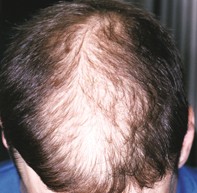Peer Reviewed
Feature Article Dermatology
Androgenetic alopecia in men and women
Abstract
All men and women suffer androgenic hair loss as they age. Androgenic alopecia becomes a problem only when the hair loss is perceived as excessive, premature and distressing.
Key Points
- Some degree of bitemporal recession occurs in 65% of women and 95% of men; however, neither the presence nor severity of bitemporal recession correlates with vertex or midfrontal scalp hair loss. Bitemporal recession does not respond to finasteride or oral antiandrogens.
- Finasteride will arrest hair loss in 90% of men and stimulate hair regrowth to some degree in over 60%.
- Oral antiandrogens will arrest hair loss in over 90% of women and stimulate hair regrowth to some degree in over 30%.
- Topical minoxidil will produce visible hair regrowth in over 50% of men and women within six months, but might not arrest further hair loss.
- Diagnosis of female pattern hair loss is facilitated by the use of the described clinical grading scale. Women with grade 3, 4 or 5 hair loss have androgenetic alopecia.
- Up to 60% of women presenting with increased hair loss but who appear to have normal hair density on examination (grade 1 or 2) will have demonstrable androgenetic alopecia on scalp biopsy. Doctors should be wary of too eagerly reassuring women who claim to be losing hair but who have little visible hair loss.
Purchase the PDF version of this article
Already a subscriber? Login here.

